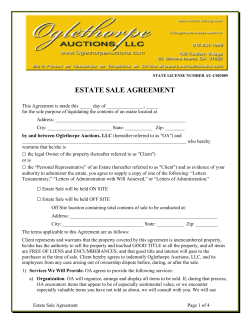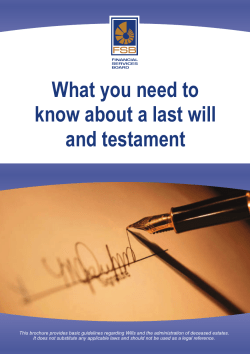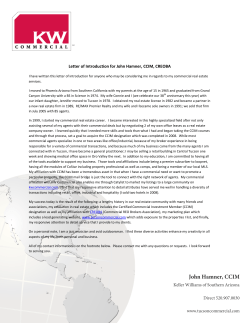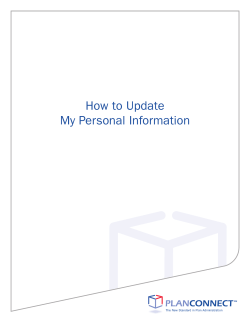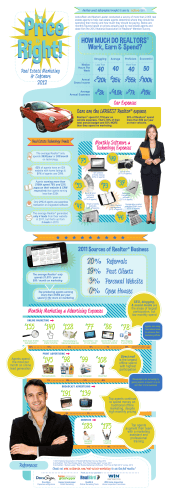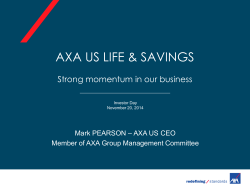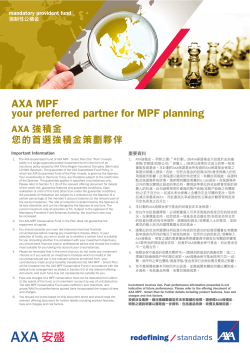
the ten common life insurance mistakes (and how to avoid them)
the ten common life insurance mistakes (and how to avoid them) By Steve Leimberg of Leimberg Associates, Inc. This entire commentary is devoted to mistakes involving your personal and business life insurance. The mistakes are those that have occurred over and over — in fact, countless times. Each of these mistakes has two things in common: First, each has potentially serious consequences in terms of both expense and aggravation. Second, each could easily have been avoided, or if found in time can be corrected quickly and inexpensively. There is a relatively simple solution to each of these ten common mistakes. Who cares if these ten mistakes are not found and fixed? Certainly not the IRS. It profits from the mistakes of omission or commission made by others. The parties who care most are those that must make do with less or do without. Think about it. 1 Mistake 1 — You named your estate as a beneficiary The Problem: Naming your estate as beneficiary of your life insurance dooms the proceeds (in many states) to needless state inheritance taxes or to a higher rate than if the proceeds were payable to a named beneficiary. This mistake also makes it certain that creditors have full access to the life insurance proceeds even though most states’ laws provide full or significant exemption from the claims of creditors for life insurance payable to named beneficiaries such as a spouse, children, parent, or sibling. By naming your estate as your beneficiary, you guarantee that the precious dollars you wanted to go to a loved one will be subjected to the expense and potential aggravation and delay of probate. The Solution: Change the beneficiary of your group insurance at work and your individually owned policies to the persons or organizations you really want to receive it. Cut out the taxman and others who you don’t want to be recipients of your life insurance. © 2011 Reprints of this article are available from Leimberg Associates, Inc. 144 West Eagle Road, Havertown, PA 19083, (610) 924-0515 or www.leimberg.com Life Insurance Products: • Are Not a Deposit of Any Bank • Are Not FDIC Insured • Are Not Insured by Any Federal Government Agency • Are Not Guaranteed by Any Bank or Savings Association • Variable Life Insurance May Go Down in Value 2 Mistake 2 — You failed to name at least two “backup” beneficiaries The Problem: If the beneficiary you named dies before you do (even if only minutes before you), and you don’t make a later change, the proceeds will be paid to your estate. This needlessly subjects it to all the problems of Mistake 1, just as if you had named your estate as your life insurance beneficiary. The Solution: Employ the “Rule of Two.” Name two backups for every person named in your life insurance policy as a beneficiary. (The Rule of Two is a good practice for all your dispositive documents and contracts. For instance, provide in your will, your trust, your pension or profit-sharing plan, your IRA or HR-10 two backup beneficiaries and two backup guardians for your children. Provide two backup executors and/or trustees in case those you’ve named for some reason fail to qualify or cease to act.) 3 Mistake 3 — You failed to check your policies at least every three years The Problem: Many policies are payable to ex-spouses or others whom the insureds would not have wanted to receive the proceeds. Children born after a policy was purchased are often inadvertently omitted. This occurs because it’s easy to forget whom you named as the beneficiary of your life insurance five or ten years ago. Forgoing a once-every-three-years checkup also makes it likely that you may not have the best possible type of policy to meet your present needs. The Solution: Have your insurance company confirm — in writing — that the policies are in force, who the beneficiaries are, and that your waiver of premium (a contractual provision that assures your policy is kept in force and continues coverage even if you can’t pay the premiums because of disability) is effective. Check to see if the beneficiaries named are the people you want now as your beneficiaries and that the policy proceeds are payable to them in the manner that best meets their needs, abilities, and circumstances. 4 Mistake 4 — You haven’t matched the product with the problem (you’ve got the wrong type of life insurance) The Problem: If you have a short-term product that will or may run out when you need it the most, you forfeit one of the most important benefits of buying life insurance: peace of mind. How can life insurance provide the mental comfort intended if it may not work when it is needed the most? The Solution: Check with a knowledgeable professional to see if you have the right type of life insurance for your present needs and circumstances. There are many new types of policies that have become available in the last few years that were not possible or even considered in the past. These policies may be more appropriate to your present needs and circumstances than your current coverage. Never drop a policy before demanding a written list of the disadvantages and downsides. For instance, typically, if you replace an old policy with a new one, your new contract will be contestable by the insurer for the next two years. Don’t drop a policy because you are wealthy with other assets unless you are sure that property can be converted into immediate cash without a big loss. Don’t switch to a new policy because the one you have is “old-fashioned.” Some older policies allow borrowing at 5% or 6% and are paying dividends that equal or exceed premiums. (If you really need more coverage, the smartest course of action may be to keep the policy you have and obtain a new separate policy.) Ask questions. Demand answers. If an interest rate is shown in one company’s illustration, make sure it’s reasonable (long term) and then make sure the same rate is used in all comparisons. Before switching, ask to see if a tax-deferred “Section 1035 policy exchange” is possible. © 2011 Reprints of this article are available from Leimberg Associates, Inc. 144 West Eagle Road, Havertown, PA 19083, (610) 924-0515 or www.leimberg.com 5 Mistake 5 — The amount of your personal coverage is inadequate for your family financial security goals The Problem: Who’s going to pay for your family’s food, clothing, and shelter and education costs for the next X years? (Figure roughly that to raise a child through age 21 (excluding college costs), the average cost exceeds $250,000 — about $70,000 for food alone!) Will those you love have enough after taxes, the payment of debts, and other expenses to just go on living? If you haven’t recently checked, how do you know? The Solution: Obtain a no-nonsense insurance analysis of what you have and what your family will need if you die — and what you would need if you became disabled. A couple of hours with a competent professional may save your family’s financial way of life. Over and above all the amounts necessary to keep your family at the standard of living you feel is appropriate, consider having your spouse own and be beneficiary of life insurance equal to at least one year’s gross income on your life. This is what is often called a “Survivor’s Shock Absorber.” Psychologically, this “buys time” for the surviving spouse to readjust. He or she knows that — financially at least — for one whole year — nothing has to change and no snap decisions are necessary about moving or making radical adjustments in life style. 6 Mistake 6 — Your policy is payable outright to your minor children or grandchildren The Problem: Improper disposition of assets is one of the most frequent and serious of all estate planning errors. It occurs when the wrong asset goes to the wrong person at the wrong time in the wrong manner. “Equal is not necessarily equitable.” Perhaps your children have different needs. Should they all receive equal shares of your life insurance? Should they receive their shares outright? Are they currently mature enough to handle such a large amount? Are they sophisticated enough to invest it wisely? In many cases, state law will tie up those proceeds and make it expensive or time-consuming for minor beneficiaries to use the money. Why? Because minors are under a legal disability. No insurance company will knowingly pay large amounts outright to minor children. So, a guardian or custodian will have to be appointed by court at your children’s expense to dole out their money to them. The Solution: Often, the best solution is to set up a trust for your spouse and children and name the trust as the recipient of your life insurance proceeds. You can build in a great deal of flexibility and sidestep a number of the legal restrictions imposed on outright distributions. This is a much safer and surer way to provide financial security for those who can’t or don’t want to handle large sums of money or other assets. A very cost-effective alternative where the amount involved is more modest (or for any reason a trust is impractical or not desired) is to have the insurer pay out policy proceeds under what is called a “settlement option,” which provides a steady and consistent small amount of cash monthly over a long period of time. © 2011 Reprints of this article are available from Leimberg Associates, Inc. 144 West Eagle Road, Havertown, PA 19083, (610) 924-0515 or www.leimberg.com 7 Mistake 7 — All the insurance on your life is owned by you The Problem: If your estate is likely to be large enough to be exposed to federal estate taxes, owning insurance in your own name may lead to needless federal estate tax inclusion, which in turn usually results in unnecessary federal (and in some cases state) estate tax liability. The Solution: To avoid federal estate tax on life insurance proceeds, you may want to have a trust or an adult beneficiary purchase, own, and be recipient of insurance on your life. If you never own the policy or have any rights in it, under present tax law, it can’t be included in your estate (even if you give your adult child or trustee cash gifts that are then used to pay premiums). 8 Mistake 8 — You haven’t checked to see if your business or professional practice can provide insurance on a more efficient basis The Problem: If you own, control, or have a voice in the decision making process of a closely or publicly held business, those business dollars may be much more tax and cash flow cost-effective than dollars you take out of your own pocket to provide for your family’s financial security. In a nutshell, it may be costing more than it should if you are paying for life insurance entirely with after-tax personal dollars. The Solution: Consider with your financial advisors how to maximize business-sponsored life insurance benefits. Ask for a breakdown of the advantages and disadvantages of DBO (Death Benefit Only) plans, Nonqualified Deferred Compensation, Section 162 Plans, Group Term Life Insurance, Group Term Carve-Outs, and Split-Dollar Life Insurance. If your business is incorporated and any of these terms are unfamiliar to you, it’s a good sign that you need to look into what such plans can do for you and your family. 9 Mistake 9 — You forgot that term insurance (including group term coverage) runs out and/or becomes prohibitively expensive to carry The Problem: We tend to confuse the terms “low outlay” with “inexpensive.” Low outlay is a measurable relationship of the premium dollars required to carry one policy with the number of dollars to purchase another policy. Term insurance will almost always require a lower outlay than whole life of any type. “Inexpensive” is a term that demands that we measure what our dollars have accomplished, i.e., the relative cost efficiency of meeting our goal. You should be asking, therefore, “what type of life insurance policy has the highest probability of accomplishing my objectives?” If the policy never accomplishes your objective(s), it is the most expensive — no matter how low the outlay! The Solution: Use temporary (term) products (such as term insurance) when the duration of the need is definitely short term. Use long-term products such as a form of permanent insurance — when the need is long-term or indefinite. Use a combination of term and whole life if you are not sure how long the need will last — or if your cash flow is inadequate to meet the need totally with a form of permanent coverage. In other words, “match the product to the problem.” © 2011 Reprints of this article are available from Leimberg Associates, Inc. 144 West Eagle Road, Havertown, PA 19083, (610) 924-0515 or www.leimberg.com If term insurance is appropriate to solve the problem, consider long-term locked-in-price term contracts — but be sure you can convert to a viable permanent contract at a reasonable price. You’ll want permanent coverage if you are highly successful for business and estate liquidity needs. You’ll want permanent coverage if you are not financially successful since it may be the only way to support the life style of those you love. You’ll want permanent coverage if you’ve misjudged the length of the duration of the need. For instance, many individuals mistakenly thought the cost of their lifestyle would drop at retirement while many others never anticipated the need to provide financial support for parents (and even children) after they (the insureds) retired. 10 Mistake 10 — You buy life insurance as though it were a commodity The Problem: If you think all life insurance — even from the same company — is equal, think again. For instance, a mistake in setting up life insurance can cost tens of thousands of dollars! Transfer life insurance to the wrong party in the wrong manner and the income-tax-free status of the death proceeds is lost. Instead of being income-tax-free, the death benefit is taxable. The Solution: How life insurance is arranged and the quality of advice and the peace of mind you gain when it is properly coordinated to most efficiently and effectively accomplish your objectives can make all the difference. For instance, by setting up life insurance through an irrevocable life insurance trust rather than owning it outright, it’s possible to save a significant portion of the death benefit from federal and state death taxes. Search out a competent, compassionate professional who “gets things done,” who — after listening to you — asking you questions — puts your priorities and best interests first. Look for someone willing to pay the price of establishing a relationship rather than someone looking for a quick sale. You need a person who will keep you informed when the tax laws change and make sure you’re up to date on the legitimate tax-saving mechanisms under the tax law. Life insurance contracts are not all alike. The lowest price or the highest possible return are not always the hallmark of the right policy. The economic history of the past proves the danger of always shopping for the “lowest-priced” policy. The records show that many insurance companies that didn’t have the lowest premiums or offer to pay the highest dividends are the companies that were (and continue to be) the most financially sound and fiscally responsible. There is a difference in the quality of insurance companies that stand behind the policy that you buy! One good way to judge an insurance company’s quality is by examining the type of person who serves as the company’s agent. Ask for references. Talk to other people who have dealt with that agent. Find out if your agent is (or is studying to become) a CLU (Chartered Life Underwriter), ChFC, (Chartered Financial Consultant), CFP (Certified Financial Planner), or has an MSFS (Masters in Financial Services). Ask your professional when he or she took their last continuing education course in insurance, income taxation, or estate planning. © 2011 Reprints of this article are available from Leimberg Associates, Inc. 144 West Eagle Road, Havertown, PA 19083, (610) 924-0515 or www.leimberg.com Conclusion Life insurance may be one of the most important purchases you (and/or your business) will ever make. As is the case with any important purchase, it pays dividends to avoid the pitfalls into which you can so easily fall. You can avoid these common mistakes if you follow this simple checklist: •D on’t name your estate as the beneficiary of your insurance. •N ame at least two backup beneficiaries. •A t least every three years, request a written confirmation of the status of your policies and beneficiaries. •M atch the product to your problem. Be sure you’ve got the right policy for your needs. •A bove all, be sure you’ve got enough life insurance to provide food, clothing and shelter, and to pay off debt so that those you love can continue in their present life style. •D on’t name minors as outright beneficiaries. Consider a trust or settlement option. •C onsider a transfer of life insurance to others to save federal estate taxes. •C heck to see if your business or professional practice can provide your family with insurance on a more cost-effective basis. •R emember that term insurance, by definition, runs out and contractually becomes more expensive as you grow older. •D on’t buy life insurance as though it were a commodity. The knowledge of the agent with whom you deal and the integrity of the insurer and its commitment to service can make a major difference as to how cost-effective your insurance will be. To learn more about life insurance planning, you may want to read Steve Leimberg’s books, Tools and Techniques of Life Insurance Planning (800-543-0874), Tax Planning with Life Insurance: Financial Professional’s Edition (800-950-1216) and The Book of Trusts, 4th Edition (610-924-0515). Also, be sure to contact the professional who cared enough to provide you with this brochure. Insurance products are issued by AXA Equitable Life Insurance Company (AXA Equitable). Variable life insurance is co-distributed by affiliates AXA Advisors, LLC and AXA Distributors, LLC, New York, NY 10104. Fixed life insurance is co-distributed by AXA Network, LLC and AXA Distributors, LLC. Reprinted with the permission of Stephen R. Leimberg. AXA Equitable and its affiliates are not affiliated with Stephen R. Leimberg. © 2012 AXA Equitable Life Insurance Company. All rights reserved. 1290 Avenue of the Americas, New York, NY 10104, (212) 554-1234 GE-67180 (2/12) G28847 Cat. #139112 (2/12)
© Copyright 2025





